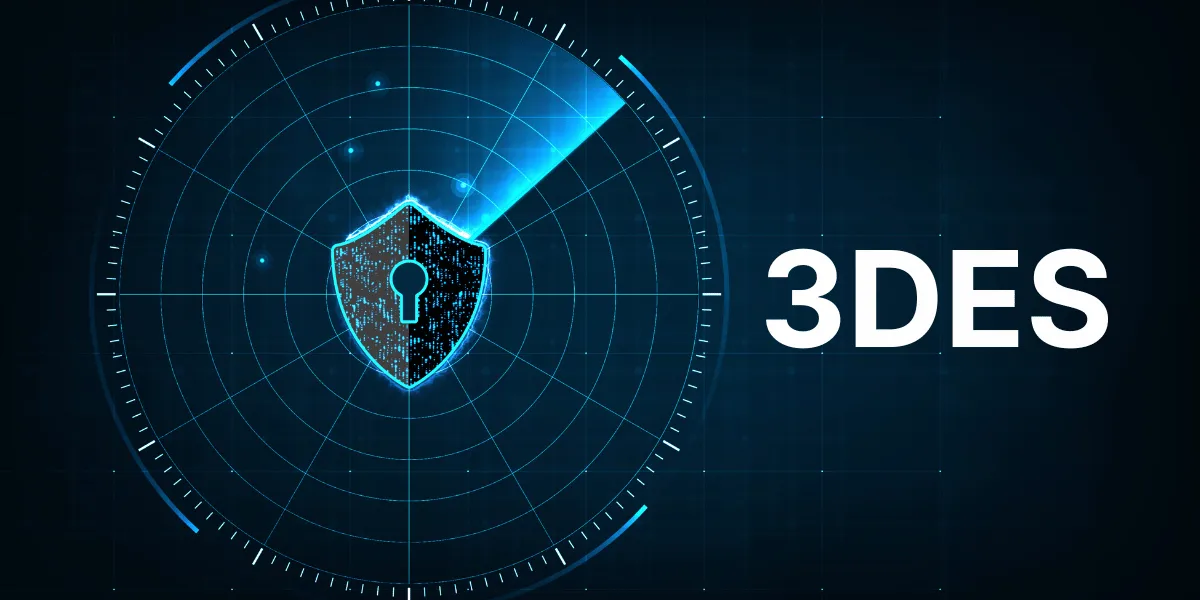What is 3DES Encryption?
3DES, also known as Triple DES or TDES, is an encryption algorithm that improves on the original DES (Data Encryption Standard) algorithm by using it three times on each data block. DES was developed in the 1970s by IBM and adopted by the US government as an official standard in 1977. However, as computing power increased, DES was eventually cracked and found to be insecure.
3DES was created to overcome DES’s vulnerabilities without building a completely new algorithm. It is based on applying the DES algorithm three times in a row to each data block using different keys each time. This makes 3DES much more resistant to brute-force attacks compared to standard DES.
Key Takeaways
- 3DES applies the DES encryption algorithm three times to each data block.
- It uses a different key for each of the three DES operations.
- 3DES has a key length of 168 bits – three 56-bit DES keys.
- 3DES is slower than DES but much more secure.
- 3DES is approved for sensitive US government data up to TOP SECRET.
- 3DES is vulnerable to meet-in-the-middle attacks, reducing its effective key size to 112 bits.
How DES Encryption Works?
To understand 3DES, we must first examine the original DES algorithm. DES is a symmetric key block cipher that uses a 56-bit key to encrypt 64-bit blocks of data. Here is an overview of how DES encryption works:
- The 64-bit plaintext block is passed through an initial permutation (IP) function.
- The permuted block is then split into two 32-bit halves, L0 and R0.
- There are then 16 rounds of encryption performed on the halves. In each round:
- The right half (R) is expanded to 48 bits using an expansion function E.
- The expanded half is then XORed with a 48-bit subkey (Ki).
- The result is fed into 8 S-Box substitution functions that reduce the 48 bits to 32 bits.
- A fixed permutation (P) is applied to the 32-bit S-Box output.
- The permuted 32 bits are then XORed with the left half (L) to produce the new R.
- The previous R becomes the new L.
- After the 16 rounds, the final L and R halves are rejoined.
- An inverse initial permutation (IP-1) is applied to produce the 64-bit ciphertext block.
The 56-bit encryption key generates sixteen 48-bit subkeys—one for each round. This key schedule produces subkeys using permutations and shifts based on the original key.
Overall, DES combines permutations, substitutions, and XOR operations using the subkey bits to create a complex nonlinear transformation on each 64-bit block. This provides confusion and diffusion which is an effective technique for producing ciphertext.
However, with increases in computing power, DES, with its relatively small 56-bit key, was eventually cracked with brute-force techniques like exhaustive key search. 3DES was created to overcome this vulnerability while still using the DES algorithm as a building block.
How 3DES Encryption Works?
3DES applies the DES encryption algorithm three times to each data block. Here is the process:
- First DES encryption: The plaintext is encrypted with the first key (K1) using standard DES to produce an intermediate ciphertext.
- Second DES decryption: The intermediate ciphertext is decrypted with the second key (K2) using DES to produce an intermediate plaintext.
- Third DES encryption: The intermediate plaintext is encrypted again with the third key (K3) using DES to produce the final ciphertext.
Decryption is the reverse, decrypting with K3, encrypting with K2, then decrypting with K1.
In summary, 3DES performs DES encrypt, DES decrypt, and DES encrypt using three different key values on each 64-bit block.
This triple application of DES makes 3DES much more resistant to brute force attacks. A brute force key search attack on DES only has to test 2^56 possible keys to crack the algorithm. With 3DES, there are 2^56 possible combinations for each of the three keys, so an exhaustive key search would have to test 2^56 x 2^56 x 2^56 = 2^168 possible keys.
3DES Key Length and Strength
The key length for 3DES is 168 bits since three separate 56-bit keys are used. However, there is a meet-in-the-middle attack on 3DES that reduces its effective key strength to 112 bits. This attack works by decrypting the first and second stages with all possible keys and comparing the results. Matches will reveal the two keys used for those stages.
With sufficient memory, this attack allows the first and third keys to be determined with just 2^56 operations and storage for 2^56 blocks. The computational complexity is reduced from 2^168 to 2^112. While still very strong, this means 3DES only has an effective 112-bit key, not the full 168 bits.
Despite this vulnerability, 112-bit security is still sufficient for extremely sensitive data today. 3DES has been approved for encrypting TOP SECRET US government information, though additional protections, such as a 192-bit keying option, are stipulated. When properly implemented, 3DES will remain secure against brute force attacks for the foreseeable Future.
- Connecting to shared folders or printers: Port 139 allows NetBIOS name resolution so clients can locate and connect to shared folders and printers on Windows servers and workstations. The NetBIOS session established over port 139 also handles authentication.
- Browsing the network: When viewing other computers and shared resources on the LAN, NetBIOS name queries are resolved using port 139.
- Using remote administration tools: Management tools like Remote Desktop, WinRM, and others depend on port 139 being available. The ADMIN$ share used for remote management leverages port 139.
- Running Windows services: Core Windows services like Server Message Block (SMB), which enable file/print sharing, are heavily dependent on NetBIOS sessions over port 139.
- Legacy applications: Older Windows applications designed to run over NetBIOS may require port 139 to be open in order to function properly.
3DES Key Generation and Management
Proper key generation and management are critical to achieving the full security potential of any encryption algorithm. For 3DES, there are several recommended keying options:
Unique Keys (Strongest)
This uses three completely different 56-bit keys for the three DES operations. It provides full 168-bit theoretical key strength against brute force attacks. Generating and managing three distinct keys is required.
Two-Key 3DES
Uses K1=K3 while K2 is different. Convenient for migration from DES, where K2 is a new key. Provides effective 112-bit security.
Three-Key 3DES (Weakest)
Uses three identical keys: K1=K2=K3. Provides only 56-bit strength like regular DES. It should be avoided.
Keys should be generated using a cryptographically secure pseudorandom number generator (CSPRNG) and handled properly to prevent compromise or reuse. The National Institute of Standards and Technology (NIST) guides the appropriate generation, storage, and handling of cryptographic keys.
Some important key management principles for 3DES include:
- Generate keys from a true CSPRNG with sufficient entropy.
- Store keys securely encrypted while not in use.
- Transmit keys only over secured channels.
- Update or re-generate keys periodically based on an established policy.
- Use unique keys for each application – do not reuse keys.
- Keys should be at least 112 bits for strong 3DES implementation.
Proper key hygiene prevents many potential attacks on the algorithm like brute force cracking.
3DES Applications and Use Cases
Although its adoption has declined in favor of AES, 3DES is still used in a number of applications and systems due to its supported status in standards and long history of cryptanalysis:
- Banking: Used in PIN generation, ATM transactions, and card verification values
- Government: Authorized by NIST for protecting classified data at 80 and 112-bit key strength
- Payment processing: Found as part of dedicated HSMs in the finance industry
- Information security: Encryption of legacy systems and data where transition to AES may be difficult
- Smart cards: Embedded use in cryptographic modules
- Cloud services: Pseudorandom number generation, key wrapping algorithms
3DES will likely fade away in favor of AES over time but remains secure and in active use today, where compatibility with existing systems is required. It offers a practical encryption option during periods of technology transition.
The Future of 3DES
Looking ahead, 3DES is expected to reach end-of-life status in the next decade. NIST has declared DES and 3DES to be officially retired, though they will remain in widespread use as legacy algorithms for some time. The 2023 sunset date calls for triple-DES upgrades where possible.
The primary reason for moving beyond 3DES is faster and stronger advanced encryption algorithms like AES which offer greater security as well as improved performance. In most applications, AES is recommended today rather than 3DES when implementing new cryptography.
However, throughout the transition period, 3DES will continue to have a place in securing older systems and providing backward compatibility. The 3DES algorithm is well-analyzed and sufficient for many years of continued operation in legacy environments. Strict cryptographic data destruction practices will be necessary once 3DES is fully deprecated.
Final Thoughts
In summary, 3DES improves upon the obsolete DES algorithm by applying it three times with different keys per data block. This increases the key size to 168 bits and makes brute-force attacks infeasible for the foreseeable Future. While meet-in-the-middle attacks reduce its strength, it still provides robust security when correctly implemented with 112+ bit keys and proper key management.
3DES is firmly entrenched in many existing systems and standards, keeping it active today as a legacy algorithm. The future points towards the transition to more efficient and advanced ciphers like AES across most applications. But 3DES will continue its role in securing sensitive data in legacy environments as older systems are phased out. Understanding how it works provides important cryptographic knowledge applicable to modern encryption.
Frequently Asked Questions
What is the main difference between DES and 3DES?
The main difference is that 3DES applies the DES cipher three times to increase the key length. DES uses 56-bit keys, whereas 3DES uses three 56-bit keys for a total of 168 bits. This makes 3DES much more resistant to brute-force attacks.
What are the three keys in 3DES?
3DES has three 56-bit keys that are used in three successive DES operations: K1 encrypts the plaintext initially, K2 decrypts the first ciphertext, and K3 encrypts the resulting plaintext again to produce the final ciphertext.
Is 3DES stronger than AES?
No, AES is considered stronger than 3DES. AES offers higher security, up to 256-bit keys, and is significantly faster in software and hardware. 3DES only has an effective key strength of 112 bits due to meet-in-the-middle attacks.
How is 3DES vulnerable to meet-in-the-middle attacks?
Meet-in-the-middle attacks precompute intermediate ciphertexts for all possible K1 and K2 keys. By comparing these to the actual intermediate ciphertext during encryption, the first two keys can be determined, which breaks the full 3DES key.
Should new systems still implement 3DES today?
Generally, no. AES is recommended for new system designs rather than 3DES, which remains in use only for compatibility reasons in legacy environments. Overall, AES offers better performance and security.

Priya Mervana
 Verified Web Security Experts
Verified Web Security Experts
Priya Mervana is working at SSLInsights.com as a web security expert with over 10 years of experience writing about encryption, SSL certificates, and online privacy. She aims to make complex security topics easily understandable for everyday internet users.



